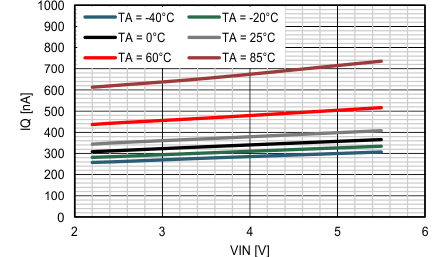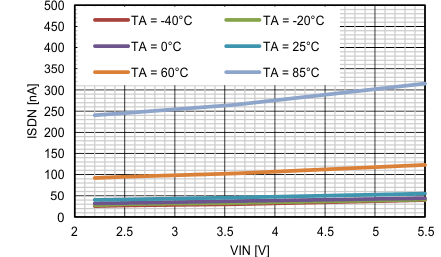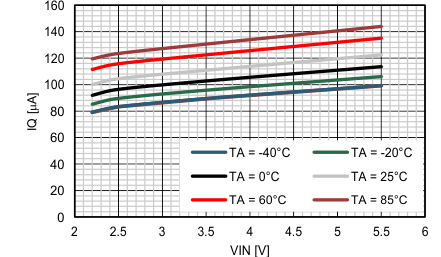SLVSCX0B February 2016 – April 2016 TPS62770
PRODUCTION DATA.
- 1 Features
- 2 Applications
- 3 Description
- 4 Revision History
- 5 Pin Configuration and Functions
- 6 Specifications
- 7 Detailed Description
- 8 Application and Implementation
- 9 Power Supply Recommendations
- 10Layout
- 11Device and Documentation Support
- 12Mechanical, Packaging, and Orderable Information
Package Options
Mechanical Data (Package|Pins)
- YFP|16
Thermal pad, mechanical data (Package|Pins)
Orderable Information
6 Specifications
Absolute Maximum Ratings
over operating free-air temperature range (unless otherwise noted) (1)| MIN | MAX | UNIT | |||
|---|---|---|---|---|---|
| Pin voltage(2) | VIN, FB | –0.3 | 6 | V | |
| SW1 | –0.3 | VIN +0.3V | V | ||
| EN1, EN2/PWM, CTRL, BM, VSEL1-3 | –0.3 | VIN +0.3V | V | ||
| SW2, VO2 | -0.3 | 32 | V | ||
| VO1, LOAD | –0.3 | 3.7 | V | ||
| TJ | Operating junction temperature range | –40 | 125 | °C | |
| Tstg | Storage temperature range | –65 | 150 | °C | |
(1) Stresses beyond those listed under absolute maximum ratings may cause permanent damage to the device. These are stress ratings only and functional operation of the device at these or any other conditions beyond those indicated under recommended operating conditions is not implied. Exposure to absolute–maximum–rated conditions for extended periods may affect device reliability.
(2) All voltage values are with respect to network ground terminal GND.
6.1 ESD Ratings
| VALUE | UNIT | ||||
|---|---|---|---|---|---|
| V(ESD) | Electrostatic discharge | Human body model (HBM), per ANSI/ESDA/JEDEC JS-001, all pins(1) | ± 2000 | V | |
| Charged device model (CDM), per JEDEC specification JESD22-C101, all pins(2) | ±500 | ||||
(1) JEDEC document JEP155 states that 500-V HBM allows safe manufacturing with a standard ESD control process. The human body model is a 100-pF capacitor discharged through a 1.5-kΩ resistor into each pin.
(2) JEDEC document JEP157 states that 250-V CDM allows safe manufacturing with a standard ESD control process.
Recommended Operating Conditions
| MIN | NOM | MAX | UNIT | ||||||
|---|---|---|---|---|---|---|---|---|---|
| VIN | Input voltage range at VIN pin | 2.5 | 5.5 | V | |||||
| IOUT1 | DC/DC 1 Step down converter output current | L1 = 2.2µH, COUT1 = 10 µF | 300 | mA | |||||
| IOUT2 | DC/DC 2 Step up converter output current | 2.5V < VIN < 5.5V, VOUT2 = 12V, COUT2 = 10uF, L = 10µH | 30 | mA | |||||
| 2.5V < VIN < 5.5V, VOUT2 = 12V, COUT2 = 2x 10uF, L = 10µH | 100 | ||||||||
| 3V < VIN < 5.5V, VOUT2 = 5V, COUT2 = 2x 10uF, L = 4.7µH | 200 | ||||||||
| ILOAD | Load current (current from LOAD pin) | 100 | |||||||
| TJ | Operating junction temperature range | -40 | 125 | °C | |||||
| TA | Ambient temperature range | -40 | 85 | ||||||
6.2 Thermal Information
| THERMAL METRIC(1) | TPS62770 | UNIT | |
|---|---|---|---|
| YFP | |||
| TERMINALS | |||
| RθJA | Junction-to-ambient thermal resistance | 90.6 | °C/W |
| RθJCtop | Junction-to-case (top) thermal resistance | 0.6 | |
| RθJB | Junction-to-board thermal resistance | 13.8 | |
| ψJT | Junction-to-top characterization parameter | 2.8 | |
| ψJB | Junction-to-board characterization parameter | 13.7 | |
| RθJCbot | Junction-to-case (bottom) thermal resistance | n/a | |
(1) For more information about traditional and new thermal metrics, see the Semiconductor and IC Package Thermal Metrics application report, SPRA953.
6.3 Electrical Characteristics
VIN = 3.6V, TA = –40°C to 85°C typical values are at TA = 25°C (unless otherwise noted)| PARAMETER | TEST CONDITIONS | MIN | TYP | MAX | UNIT | |||
|---|---|---|---|---|---|---|---|---|
| SUPPLY | ||||||||
| ISD | Shutdown current into VIN | EN1 = EN2/PWM = GND, CTRL GND, BM = GND, | 0.1 | 1850 | nA | |||
| VTH_ UVLO+ | Undervoltage lockout threshold | Rising VIN | 2.1 | 2.22 | V | |||
| VTH_UVLO- | Falling VIN | 1.9 | 2 | |||||
| INPUTS EN1, EN2/PWM, BM, CTRL,VSEL 1-3 | ||||||||
| VIH TH | High level input threshold | 1.2 | V | |||||
| VIL TH | Low level input threshold | 0.4 | V | |||||
| IIN | Input bias Current | TJ = 25°C | 10 | nA | ||||
| TJ = –40°C to 85°C | 25 | |||||||
| STEP-DOWN CONVERTER | ||||||||
| IQ | Operating quiescent current | EN1 = VIN, EN2/PWM = GND, CTRL = GND, IOUT = 0µA, VOUT = 1.8V, device not switching, | 370 | 1850 | nA | |||
| EN1 = VIN, EN2/PWM = GND, IOUT = 0mA, CTRL = GND, VOUT = 1.8V , device switching | 500 | |||||||
| VVOUT | Output voltage range | 1.0 | 3.0 | V | ||||
| Output voltage accuracy | PFM mode | -2.5 | 0 | 2.5 | % | |||
| PWM mode | -2 | 0 | 2 | |||||
| DC output voltage load regulation | VOUT = 1.8V | 0.001 | %/mA | |||||
| DC output voltage line regulation | VOUT = 1.8V, IOUT = 10 mA, 2.5V ≤ VIN ≤ 5.5V | 0 | %/V | |||||
| RDS(ON) | High side MOSFET on-resistance | IOUT = 50mA | 0.45 | Ω | ||||
| Low Side MOSFET on-resistance | 0.22 | |||||||
| ILIMF | High side MOSFET switch current limit | 480 | 600 | 720 | mA | |||
| Low side MOSFET switch current limit | 600 | mA | ||||||
| RDSCH_VO1 | Discharge switch on-resistance | EN = GND, IVO1 = -10mA into VO1 pin | 20 | 65 | Ω | |||
| IIN_VO1 | Bias current into VO1 pin | EN = VIN, VOUT = 1.8V | TJ = 25°C | 40 | 100 | nA | ||
| TJ = –40°C to 85°C | 1010 | |||||||
| VTH_100+ | Auto 100% Mode leave detection threshold (1) | Rising VIN,100% Mode is left with VIN = VOUT + VTH_100+ , max value at TJ = 85°C | 150 | 250 | 370 | mV | ||
| VTH_100- | Auto 100% Mode enter detection threshold (1) | Falling VIN, 100% Mode is entered with VIN = VOUT + VTH_100-, max value at TJ = 85°C | 85 | 200 | 310 | |||
| tONmin | Minimum ON time | VOUT = 2.0V, IOUT = 0 mA | 225 | ns | ||||
| tOFFmin | Minimum OFF time | 50 | ns | |||||
| tStartup_delay | Regulator start up delay time | From transition EN1 = low to high until device starts switching | 1 | 5 | ms | |||
| tSoftstart | Softstart time with reduced switch current limit | 700 | 1200 | µs | ||||
| ILIM_softstart | High side MOSFET switch current limit | Reduced switch current limit during softstart | 80 | 150 | 200 | mA | ||
| Low side MOSFET switch current limit | 150 | |||||||
| LOAD SWITCH | ||||||||
| RLOAD | MOSFET on-resistance | ILOAD = 50mA, CTRL = VIN, VOUT = 1.8V, | 0.6 | 1.27 | Ω | |||
| trise_LOAD | VLOAD rise time | Starting with CTRL low to high transition, time to ramp VLOAD from 95%, VOUT = 1.8V, ILOAD = 20mA | 315 | 800 | μs | |||
| RDCHRG | MOSFET on-resistance | 20 | 65 | Ω | ||||
| STEP-UP CONVERTER | ||||||||
| IQ_VIN | Quiescent current into VIN pin | EN2/PWM = VIN, BM = GND, EN1 = GND, no load, no switching, VOUT = 12 V | 110 | 200 | µA | |||
| VOUT | Output voltage range | EN2/PWM = VIN, BM = GND | 4.5 | 15 | V | |||
| VOUT_12V | 12-V output voltage accuracy | FB pin connected to VIN pin, EN2/PWM = VIN, BM = GND | 11.7 | 12 | 12.3 | V | ||
| VFB | Feedback voltage | PWM mode, BM = GND, EN2/PWM = VIN | 0.775 | 0.795 | 0.814 | V | ||
| PFM mode, BM = GND, EN2/PWM = VIN | 0.803 | V | ||||||
| Feedback regulation voltage under brightness control | EN2/PWM = VIN, BM = VIN, | 189 | 200 | 206 | mV | |||
| VFB =50mV, BM = VIN, D(PWM) @ EN2/PWM = 25%, | 40 | 50 | 60 | mV | ||||
| VFB = 20mV, BM = VIN, D(PWM) @ EN2/PWM = 10% | 13 | 20 | 27 | |||||
| tDim_Off | Dimming signal on pin EN2/PWM | 270 | 160 | μs | ||||
| tDim_On | 1 | μs | ||||||
| VOVP | Output overvoltage protection threshold | 17 | 17.7 | 18.4 | V | |||
| VOVP_HYS | Over voltage protection hysteresis | 800 | mV | |||||
| IFB_LKG | Leakage current into FB pin | 5 | 200 | nA | ||||
| ISW_LKG | Leakage current into SW pin | EN2/PWM = GND | 5 | 500 | nA | |||
| RDS(on) | Isolation MOSFET on resistance | VOUT = 12 V | 850 | mΩ | ||||
| Low-side MOSFET on resistance | VOUT = 12 V | 450 | ||||||
| fSW | Switching frequency | VOUT = 12 V, PWM mode | 850 | 1050 | 1250 | kHz | ||
| tON_min | Minimal switch on time | 150 | 250 | ns | ||||
| ILIM_SW | Peak switch current limit | VOUT = 12 V | 730 | 970 | 1230 | mA | ||
| ILIM_CHG | Pre-charge current | VOUT = 0 V | 30 | 55 | mA | |||
| tSoftstart | Pre-charge time | BM = GND, EN2/PWM from low to high until device starts switching, IOUT2 = 0mA, COUT2 = 10uF | 6 | ms | ||||
| Startup time | VOUT from VIN to 12 V, COUT_effective = 2.2 µF, IOUT = 0 A | 6 | ||||||
(1) VIN is compared to the programmed output voltage (VOUT). When VIN–VOUT falls below VTH_100- the device enters 100% Mode by turning the high side MOSFET on. The 100% Mode is exited when VIN–VOUT exceeds VTH_100+ and the device starts switching. The hysteresis for the 100% Mode detection threshold VTH_100+ - VTH_100- will always be positive and will be approximately 50 mV(typ.)
6.4 Typical Characteristics

| EN2/PWM = Low | VOUT1 Set to 1.8 V | |
| EN1 = High | Device not Switching | |

| EN1 = EN2/PWM = Low | ||

| EN2/PWM = High | VOUT2 Set to 12 V | |
| EN1 = Low | Device not Switching | |